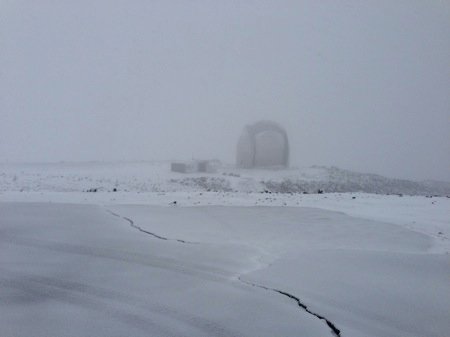I am sitting in the control room of the James Clerk Maxwell Telescope (JCMT), 14,000 feet up Mauna Kea, on Hawaii’s Big Island. I’m here to do observations for the SCUBA-2 Cosmology Legacy Survey (CLS).
I’m not really an observer — this is really my first time at a full-sized, modern telescope. But much of JCMT’s observing time is taken up with a series of so-called Legacy Surveys (JLS) — large projects, observing large amounts of sky or large numbers of stars or galaxies.
JCMT is a submillimeter telescope: it detects light with wavelength at or just below one millimeter. This is a difficult regime for astronomy: the atmosphere itself glows very strongly in the infrared, mostly because of water vapour. That’s why I’m sitting at the cold and dry top of an active volcano (albeit one that hasn’t erupted in thousands of years).
Unfortunately, “cold and dry” doesn’t mean there is no precipitation. Here is yesterday’s view, from JCMT over to the CSO telescope:
This is Hawaii, not Hoth, or even Antarctica.
Tonight seems more promising: we measure the overall quality as an optical depth, denoted by the symbol τ, essentially the probability that a photon you care out will get scattered by the atmosphere before it reaches your telescope. The JLS survey overall requires τ<0.2, and the CLS that I’m actually here for needs even better conditions, τ<0.10. So far we’re just above 0.20 — good enough for some projects, but not the JLS. I’m up here with a JCMT Telescope System Specialist — who actually knows how to run the telescope — and he’s been calibrating the instrument, observing a few sources, and we’re waiting for the optical depth to dip into the JLS band. If that happens, we can fire up SCUBA-2, the instrument (camera) that records the light from the sky. SCUBA-2 uses bolometers (like HFI on Planck), very sensitive thermometers cooled down to superconducting temperatures.
(You can keep track of the conditions here, and specifically monitor the optical depth here. News flash: as I type this, τ=0.199, less than 0.2!)
Later this week, I’ll try to talk about why these are called “Legacy” surveys — and why that’s bad news.
